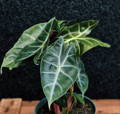The Alocasia Morocco is a gorgeous houseplant that we've found thrives growing in water. It has dar green green leaves accented with white, metallic veins. The Morocco can grow strong and tall, so this plant can develop into a centerpiece of ones home.
Although Alocasia's normally tend to be for more advanced plant parents, we've found growing them in water to be super simple. As long as the temperature and lighting conditions are not too extreme, these plants thrive. A fun fact is the leaves of the Alocasia in the tropics serve as an umbrella, blocking the rain for other plants and animals. Their leaves can grow as large as five feet across.
Native to Southeast Asia
Araceae
Elephant Ear Morocco,
Some popular types of Alocasia's are: Amazonica Poly, Zebrina,reginula ‘Black Velvet’, Dragon Scale, macrorrhiza ‘Stingray’, baginda ‘Silver Dragon’, macrorrhizos ‘Giant Taro’, cuprea ‘Red Secret’, cucullata ‘Hooded Dwarf”, Longiloba, lauterbachiana ‘Purple Sword’, Micholitziana Frydek, and Melo.
Toxic to pets and humans if consumed.

For healthy plants, we recommend that you add water to the glass every 1-2 weeks (or if you see that water levels have lowered) to replenish the water that evaporated or absorbed from the plants. Then, replace the water every 2-4 weeks.
Most tap water works great but distilled or filtered waters are recommended if available.
We recommend adding 1-2 of liquid nutrients to your philodendron's water every month. To further encourage and support leaf growth, we recommend adding an additional drop of nutrients if you see a new leaf forming.
Alocasia's love bright indirect light! They prefer areas in the home like a brightly lit corner or across a window that receives a lot of sunlight.
For Alocasia's, the ideal temperature range is 65-78 degrees Fahrenheit. A general rule of thumb for many tropical houseplants is that if you are comfortable, then they will be comfortable too!
Alocasia's prefer moderate to high humidity, but can do well in most home settings regardless of humidity level. We recommend that you spritz them with water every now and again to give it a bit of humidity.
Alocasia's easily propagate in water through most of the year. To do so, take a cutting with one or more leaves and a node or two. Submerge the node in a cup with filtered water and find a bright, warm space with indirect light for the plant. Roots generally form in 2 to 3 weeks.
Identification: brown holes in the leaves, browning tips that are crispy to the touch
Cause: Overexposure to sunlight
How to treat:Simply move your plant away from any direct sunlight or places with too much sunlight. Try placing your philodendron in a nearby area with less light exposure or somewhere where it won't have any contact with the sun. You can remove any brown tips if you like, but it's not necessary to your plant's recovery.
Identification: color patterns in the leaves are fading, leaves becoming a solid green color
Cause: When your philodendron is creating solid green leaves, this means that your plant is not receiving enough bright indirect light.
How to treat: Move your plant to an area where it would be exposed to more bright indirect light and wait for the leaves to recover their color. For newer leaves, they will gain their markings as they age.
Identification: leaves are curling at the ends or dropping, leaves also may turn yellow or brown
Cause: There are multiple causes for this issue. One, the air in your environment is too dry. Two, your plant is not receiving enough oxygen from the water. And three, your plant is experiencing extremely cold temperatures.
How to treat: To fix this issue, move your plant away from any AC vents, heaters, or open windows. Also, mist regularly if your environment is usually very dry. If the cause is a lack of oxygen, simply replace the water for the plant and then continue on a 2 week to monthly water replacement schedule.